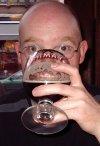 Breton beer hasn't had the best of notes when it has featured on this blog over the years. Today's set were kindly supplied by a family member who holidayed there over the summer and I wasn't in a huge rush to get them opened. But they couldn't sit in the fridge forever either, so let's see how things are going in celtic France these days.
Breton beer hasn't had the best of notes when it has featured on this blog over the years. Today's set were kindly supplied by a family member who holidayed there over the summer and I wasn't in a huge rush to get them opened. But they couldn't sit in the fridge forever either, so let's see how things are going in celtic France these days.The opener, from Brasserie Lancelot, is Blanche Hermine, named for the region's totemic mustelid. I think I'm within my rights to expect bière blanche to be cloudy, but this one is Helles-clear and brightly golden. Things normalise from the aroma onwards, which offers fresh and zingy coriander: more than is typical for the style, but it works. The texture is appropriately soft and wheaty with a gentle and controlled sparkle, something not always a given in this part of the world. Unsurprisingly, the herbal side is to the fore in the flavour, and I couldn't detect any contribution from the orange peel listed alongside. The lager effect makes a slight return in the finish, which is quick and dry. Overall, I enjoyed it. The coriander is a favourite feature of witbier, and one that most brewers understate. I'm all in for one that makes it the centrepiece, even if there's not much other complexity.
 There's always an ambrée, and I can't think of any I've enjoyed much. Chat-Malo appears to be a contract brew, produced at Brasserie de Bretagne. It includes that most Breton of ingredients, buckwheat. In the glass it's more brown than amber, and here's the wildly overactive fizz that I associate with the region's beers. The aroma gives away only slight hints of toffee and banana, a bit like a dukelweizen. Toffee continues to be part of the flavour, though the fruit goes more in a fig and date direction, with a warm pudding background plus some plum and raisin, creating an effect very similar to Belgian dubbel, and punching well above its 5.4% ABV. There's a certain swampy murk to it, but as in many Belgian dark beers, that's part of the charm. I didn't expect to like this, but on a chilly winter's night it hit the spot nicely.
There's always an ambrée, and I can't think of any I've enjoyed much. Chat-Malo appears to be a contract brew, produced at Brasserie de Bretagne. It includes that most Breton of ingredients, buckwheat. In the glass it's more brown than amber, and here's the wildly overactive fizz that I associate with the region's beers. The aroma gives away only slight hints of toffee and banana, a bit like a dukelweizen. Toffee continues to be part of the flavour, though the fruit goes more in a fig and date direction, with a warm pudding background plus some plum and raisin, creating an effect very similar to Belgian dubbel, and punching well above its 5.4% ABV. There's a certain swampy murk to it, but as in many Belgian dark beers, that's part of the charm. I didn't expect to like this, but on a chilly winter's night it hit the spot nicely. I was pleasantly surprised to find a tripel as the last beer, and this one isn't from Brittany, but further south in Pays de la Loire. It's called La Piautre Triple, La Piautre being the main brand of La Fabrique des Bières d'Anjou. It's a lovely rose-gold colour and clear with it, smelling very sweet, of honeycomb and pear drops. The latter suggests alcohol, and it's a full 8% ABV. Oddly, it doesn't taste sweet, though neither does it have the spice kick I look for in tripel. Instead, it's an odd vegetal flavour, giving me celery, raw spinach and green cabbage, with a light dusting of clove. The carbonation is much too low for the style, combining with the savoury taste to make it feel somewhat soupy. The headachey high alcohols don't make it any easier drinking either. I found this one difficult to get along with: too hot, too flat and with a flavour profile that's too off-kilter to enjoy, even as a creative twist on tripel.
I was pleasantly surprised to find a tripel as the last beer, and this one isn't from Brittany, but further south in Pays de la Loire. It's called La Piautre Triple, La Piautre being the main brand of La Fabrique des Bières d'Anjou. It's a lovely rose-gold colour and clear with it, smelling very sweet, of honeycomb and pear drops. The latter suggests alcohol, and it's a full 8% ABV. Oddly, it doesn't taste sweet, though neither does it have the spice kick I look for in tripel. Instead, it's an odd vegetal flavour, giving me celery, raw spinach and green cabbage, with a light dusting of clove. The carbonation is much too low for the style, combining with the savoury taste to make it feel somewhat soupy. The headachey high alcohols don't make it any easier drinking either. I found this one difficult to get along with: too hot, too flat and with a flavour profile that's too off-kilter to enjoy, even as a creative twist on tripel.It turns out that Brittany makes the best beer in western France, going on this set alone. Who knew? The last one was the standard I expected from them all, lacking precision and nuance. But while the others might not be about to win any medals for stylistic fidelity, at least they tasted good. Tripel is a more exacting taskmaster than perhaps the brewers in Anjou realised.





No comments:
Post a Comment